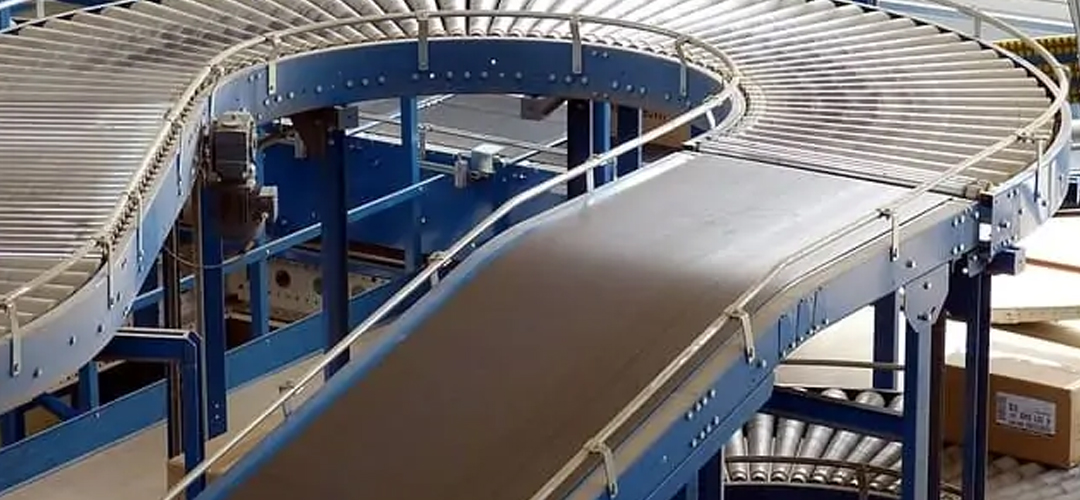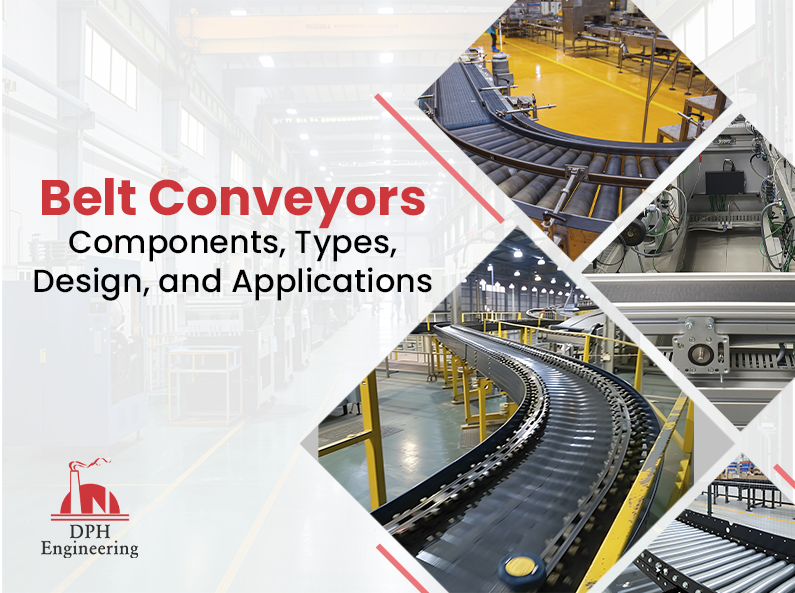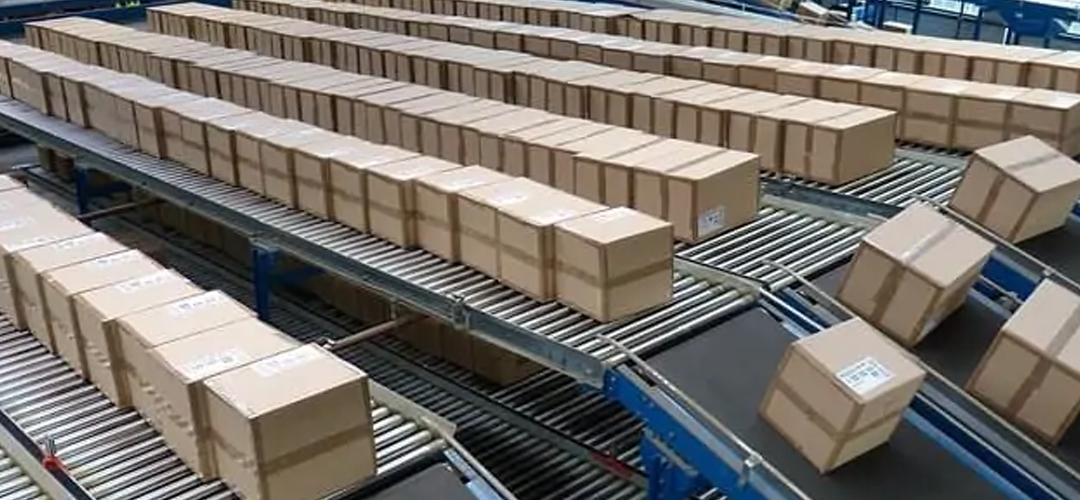A conveyor system is a quick and efficient machine used to move materials automatically within a space. This conveyor definition highlights its role in reducing mistakes, improving safety, and lowering labor costs. It is especially useful for moving large or heavy items from one place to another.
Conveyor systems can use belts, wheels, rollers, or chains to transport objects. Understanding the conveyor definition helps in choosing the right system for different tasks.
How Does a Conveyor System Work
Conveyor systems & engineering involve a belt stretched over two or more pulleys, forming a loop that continuously rotates. One pulley, known as the drive pulley, pulls the belt to move items from one place to another. Most conveyor systems use a rotor to power the drive pulley and belt. The belt adheres to the rotor due to friction. For the belt to move efficiently, both the drive pulley and the idler pulley must rotate in the same direction, either clockwise or counterclockwise.
While many conveyor systems, such as those found in grocery stores or airports, operate in a straight line, sometimes they need to navigate turns to transport items to the correct location. Special cone-shaped wheels or rotors are used to guide the belt through these turns without tangling, showcasing the advanced engineering behind modern conveyor systems.
Benefits of Conveyor Systems
The main job of a conveyor system, according to the conveyor definition, is to move items from one place to another. It is designed to handle objects that are too heavy or bulky for people to carry. Conveyor systems save time by making it easier to transport things. Since they can be tilted, they help move items up and down between different floors, which can be hard on the body when done by hand. Tilted belts can unload materials automatically, so no one needs to be at the other end to pick them up.
Types and Examples of Conveyor Systems
You might picture a big warehouse with conveyors using belts and rollers to move boxes and heavy equipment, but this is just one type of conveyor system. According to the conveyor definition, you can also find them in airports for moving luggage, or in escalators and ski lifts. These systems still use belts, chains, and pulleys to move heavy items. Knowing different types helps in understanding the full scope of the conveyor definition and its applications.
There are many types of conveyor systems, such as:
- Belt
- Roller
- Slat/apron
- Ball transfer
- Overhead
- Pneumatic
- Bucket
- Chute
- Magnetic
- Vertical
- Wheel
- Walking beam
- Vibrating
- Screw/auger
- Chain
Each type of conveyor has a specific use. For example, a slat conveyor, made of slats or plates instead of a belt, is used to move heavy materials that are too big for a regular belt system.
An escalator is an example of a chain-driven conveyor. Instead of pulleys, it uses a chain system to pull the steps up or down.
A ski lift is an overhead conveyor that uses an electric track to pull chairs up or down a mountain. Like an escalator, it also uses a chain-driven system to move things.
Essential Parts of a Conveyor System
A conveyor system has three main parts: the belt support, the pulley, and the drive unit. Each part is important for how the system works. While all conveyor systems have these parts, they can differ in how they are built and where the parts are placed.
The belt support keeps the belt moving smoothly. If the support isn’t strong enough, the belt may sag when heavy items are placed on it, causing it to move slowly or unevenly. A strong support keeps the belt tight and running properly.
The pulley system helps control the movement of the belt. There are always at least two pulleys: one powered and one idle. More complex systems may have extra pulleys to help move the belt.
The drive unit makes the conveyor system run. It has a counter bearing that helps everything move smoothly. This unit also allows the belt to move in reverse and handle changes in direction. Some conveyor systems are operated by hand, but they still use a drive unit, though it isn’t powered by a motor.
How to Choose the Right Conveyor System
A conveyor system is like the central control of operations that involve receiving, handling, storing, distributing, making, or shipping products. Choosing the right conveyor can be tough for warehouse managers because there are many types and configurations to choose from.
There are several things to think about when picking the best conveyor for your warehouse or distribution center. You need to consider both the products you’ll be moving and how the system will fit into your overall process.
The ideal conveyor system should be:
- Safe to use
- Energy efficient
- Reliable, with long-lasting parts
- Adaptable to changing needs
- Cost-effective over time
If you choose the wrong conveyor, it can hurt your warehouse’s efficiency, increase costs, lower customer satisfaction, and take away your business’s competitive edge.
Now, let’s look at the key factors to think about when selecting the right conveyor system for your operation.
Materials Used in Conveyor Systems for Impact and Wear Resistance
Conveyor systems need to be strong and durable because they move many items that can be sharp or heavy. This helps prevent damage and keeps the system working smoothly.
To handle this, conveyors use materials like UHMW, nylon, Nylatron NSM, HDPE, Tivar, Tivar ESd, and polyurethane. The choice of material depends on the conveyor’s job. If the system needs to manage static electricity, special materials are used to either release or conduct electrical charges.
Product Requirements
A conveyor system is used to move items between different areas in a distribution center. The type of items you need to move will decide the design, size, and type of conveyor system you need.
To find the best conveyor system for your facility, answer these questions to help determine the design and setup requirements:
- What type of product will be moved?
- How much does each foot of the product weigh on average?
- What is the maximum weight of the products?
- What are the minimum, maximum, and average sizes of the product (length, width, and height)?
- What are the specific dimensions of each product?
- How are the products being moved and in what position?
The weight, size, and fragility of the items will affect your choices. For example, the size of the items will determine the conveyor width and other parts, while the weight will influence the size of the rollers and motor needed.
Process Requirements
Process requirements deal with how the conveyor should operate and the specific conditions of its working environment. Here are the things to think about:
- How far do items need to move between different areas?
- The path the conveyor will follow — does it need to go up or down, turn, or avoid obstacles?
- How items should be positioned — do they need to be arranged in a certain way for scanning barcodes or transferring?
- How fast the conveyor should move — should it be quick or slow?
- The surrounding environment where the conveyor will be used.
- The amount of space available for the conveyor.
Flow Rate
Your conveyor system should be able to handle both the usual amount of items you move and any extra demand during busy times. The speed and length of the conveyor will depend on how many products you need to move each hour or minute.
Different conveyors work better for different products. For example, a large plastic chain conveyor is great for moving pallets with plastic feet, while a chain-driven roller conveyor is better for wooden pallets. The plastic chain conveyor is also better for moving smaller boxes or containers compared to the roller conveyor.
Transfer Requirements
The place where items move on and off the conveyor is very important. Most conveyors use methods like side-to-side transfers, powered transfers, flat plates, or gravity rollers to make this happen. Smaller items might need a powered transfer, while larger or longer items may need gravity rollers to move smoothly.
Integrating Conveyor Systems with Other Equipment
Conveyor systems can be combined with other equipment to create a fully automated production or distribution line. To do this, make sure all the parts work well together and that the system can handle the required load and speed.
The integration process usually involves setting up the conveyor system to work in sync with other equipment, such as sorters, palletizers, stackers, and robotic arms. This ensures that everything moves smoothly and efficiently by coordinating timing and movement.
Applications of Conveyor Systems
Conveyor systems are used in places like supermarkets, airports, and shopping centers to move both heavy items and smaller objects quickly. They’re handy in airports for getting between gates if you’re running late. While usually fixed in place, they can be connected to other systems with extra equipment.
Portable conveyors are also available and can be moved around easily. They are especially useful in logistics and parcel delivery, allowing for quick adjustments based on the volume of parcels and changing needs.
Growth of Conveyor Systems
Conveyor systems are becoming more popular in factories, packaging companies, and production plants. As the demand for these products increases, businesses need these systems more than ever to keep up with consumer needs. The most commonly used types of conveyor systems include line shaft rollers, chain conveyors, and conveyor belts.
Applications of Conveyor Systems
Conveyor systems are used in places like supermarkets, airports, and shopping centers to move both heavy items and smaller objects quickly. They’re handy in airports for getting between gates if you’re running late. While usually fixed in place, they can be connected to other systems with extra equipment.
Portable conveyors are also available and can be moved around easily. They are especially useful in logistics and parcel delivery, allowing for quick adjustments based on the volume of parcels and changing needs.
Faq
What is the principle of conveyor?
A conveyor belt works using two motorized pulleys. The belt, made of a strong material, loops around these pulleys. When both motors spin at the same speed and direction, the belt moves smoothly between them.
What is the definition of a conveyor?
A conveyor system is a type of mechanical equipment designed to move materials from one place to another. It’s particularly useful for transporting heavy or bulky items.
What is in a Conveyor System?
A conveyor system typically consists of three main parts: a frame or support for the belt, a drive mechanism, and one or more idlers. The most common type is the end drive belt conveyor, like those found at grocery store checkouts





